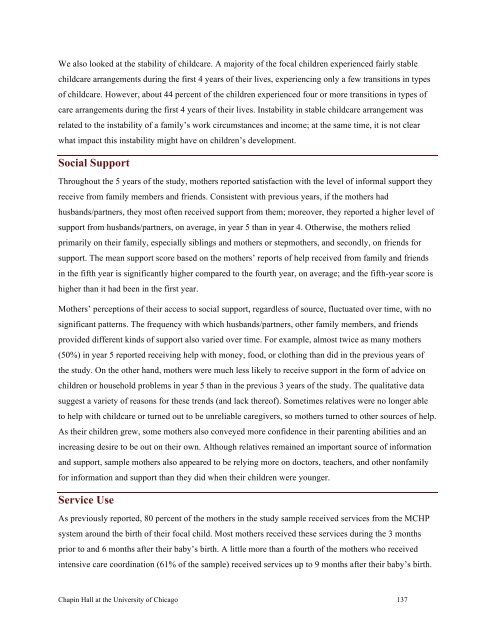2011 The Palm Beach County Family Study (Full Report)
2011 The Palm Beach County Family Study (Full Report)
2011 The Palm Beach County Family Study (Full Report)
- No tags were found...
Create successful ePaper yourself
Turn your PDF publications into a flip-book with our unique Google optimized e-Paper software.
We also looked at the stability of childcare. A majority of the focal children experienced fairly stablechildcare arrangements during the first 4 years of their lives, experiencing only a few transitions in typesof childcare. However, about 44 percent of the children experienced four or more transitions in types ofcare arrangements during the first 4 years of their lives. Instability in stable childcare arrangement wasrelated to the instability of a family’s work circumstances and income; at the same time, it is not clearwhat impact this instability might have on children’s development.Social SupportThroughout the 5 years of the study, mothers reported satisfaction with the level of informal support theyreceive from family members and friends. Consistent with previous years, if the mothers hadhusbands/partners, they most often received support from them; moreover, they reported a higher level ofsupport from husbands/partners, on average, in year 5 than in year 4. Otherwise, the mothers reliedprimarily on their family, especially siblings and mothers or stepmothers, and secondly, on friends forsupport. <strong>The</strong> mean support score based on the mothers’ reports of help received from family and friendsin the fifth year is significantly higher compared to the fourth year, on average; and the fifth-year score ishigher than it had been in the first year.Mothers’ perceptions of their access to social support, regardless of source, fluctuated over time, with nosignificant patterns. <strong>The</strong> frequency with which husbands/partners, other family members, and friendsprovided different kinds of support also varied over time. For example, almost twice as many mothers(50%) in year 5 reported receiving help with money, food, or clothing than did in the previous years ofthe study. On the other hand, mothers were much less likely to receive support in the form of advice onchildren or household problems in year 5 than in the previous 3 years of the study. <strong>The</strong> qualitative datasuggest a variety of reasons for these trends (and lack thereof). Sometimes relatives were no longer ableto help with childcare or turned out to be unreliable caregivers, so mothers turned to other sources of help.As their children grew, some mothers also conveyed more confidence in their parenting abilities and anincreasing desire to be out on their own. Although relatives remained an important source of informationand support, sample mothers also appeared to be relying more on doctors, teachers, and other nonfamilyfor information and support than they did when their children were younger.Service UseAs previously reported, 80 percent of the mothers in the study sample received services from the MCHPsystem around the birth of their focal child. Most mothers received these services during the 3 monthsprior to and 6 months after their baby’s birth. A little more than a fourth of the mothers who receivedintensive care coordination (61% of the sample) received services up to 9 months after their baby’s birth.Chapin Hall at the University of Chicago 137
















